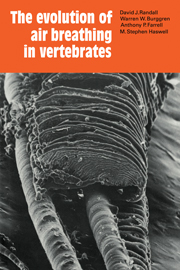Book contents
- Frontmatter
- Contents
- Preface
- 1 Introduction: air breathing in vertebrates
- 2 Gas transfer: the transition from water to air breathing
- 3 Ventilation and perfusion relationships
- 4 Mechanisms of ventilation
- 5 Regulation and control of gas transfer
- 6 The evolution of air breathing: a synthesis and summary
- References
- Index
4 - Mechanisms of ventilation
Published online by Cambridge University Press: 01 March 2011
- Frontmatter
- Contents
- Preface
- 1 Introduction: air breathing in vertebrates
- 2 Gas transfer: the transition from water to air breathing
- 3 Ventilation and perfusion relationships
- 4 Mechanisms of ventilation
- 5 Regulation and control of gas transfer
- 6 The evolution of air breathing: a synthesis and summary
- References
- Index
Summary
Very different modes of ventilation exist for lungs and gills. In fish a pressure gradient drives a unidirectional flow of water across the gills from the buccal cavity to the opercular cavities (Figure 4.1a). The synchronized action of a buccal pump and an opercular pump generates the pressure gradient. Mammalian lungs, however, are tidally ventilated by aspiration. Below-ambient pressures are developed within the lung through expansion of the thoracic cage to draw air into the lung (Figure 4.1b). Thus the evolution of air breathing in vertebrates has been associated with a change from a unidirectional mode of ventilation of a respiratory surface with water to one with a tidal mode of ventilation with air using aspiration. Clearly these changes are dictated by the marked differences in density and viscosity between air and water (see Chapter 2).
Most bimodally breathing vertebrates use a modified buccal force pump to ventilate their air-breathing organ. The modified buccal force pump is analogous to, if not homologous to, the buccal pump used to ventilate the gills. The positive-pressure phase of the buccal pump is utilized to force-ventilate the air-breathing organ. These three major forms of vertebrate ventilation are shown schematically in Figure 4.2 and Table 4.1.
To examine the evolution of air-breathing mechanisms, we must first consider gill ventilation in fish breathing water, particularly the nature of the buccal force pump.
- Type
- Chapter
- Information
- The Evolution of Air Breathing in Vertebrates , pp. 77 - 105Publisher: Cambridge University PressPrint publication year: 1981



